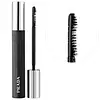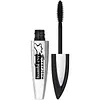What's inside
What's inside
 Key Ingredients
Key Ingredients

 Benefits
Benefits

 Concerns
Concerns

No concerns
 Ingredients Side-by-side
Ingredients Side-by-side

Water
Skin ConditioningOryza Sativa Cera
Skin ConditioningCI 77499
Cosmetic ColorantPotassium Cetyl Phosphate
EmulsifyingAcrylates Copolymer
Cera Alba
EmollientCopernicia Cerifera Cera
EmollientSteareth-2
EmulsifyingPentylene Glycol
Skin ConditioningCetyl Alcohol
EmollientHydroxyethylcellulose
Emulsion StabilisingAcacia Senegal Gum
MaskingSodium Dehydroacetate
PreservativeCaprylyl Glycol
EmollientHydrogenated Jojoba Oil
AbrasiveHydrogenated Palm Oil
EmollientHydrolyzed Hyaluronic Acid
HumectantLaureth-21
CleansingLactic Acid
BufferingSodium Hyaluronate
HumectantWater, Oryza Sativa Cera, CI 77499, Potassium Cetyl Phosphate, Acrylates Copolymer, Cera Alba, Copernicia Cerifera Cera, Steareth-2, Pentylene Glycol, Cetyl Alcohol, Hydroxyethylcellulose, Acacia Senegal Gum, Sodium Dehydroacetate, Caprylyl Glycol, Hydrogenated Jojoba Oil, Hydrogenated Palm Oil, Hydrolyzed Hyaluronic Acid, Laureth-21, Lactic Acid, Sodium Hyaluronate
Water
Skin ConditioningParaffin
PerfumingPotassium Cetyl Phosphate
EmulsifyingAcrylates Copolymer
Cera Alba
EmollientCopernicia Cerifera Cera
EmollientEthylene/Acrylic Acid Copolymer
Emulsion StabilisingSteareth-2
EmulsifyingCetyl Alcohol
EmollientPhenoxyethanol
PreservativeHydroxyethylcellulose
Emulsion StabilisingAcacia Senegal Gum
MaskingEthylenediamine/Stearyl Dimer Dilinoleate Copolymer
Skin ConditioningSodium Dehydroacetate
PreservativeCaprylyl Glycol
EmollientHydrogenated Jojoba Oil
AbrasiveHydrogenated Palm Oil
EmollientPropylene Glycol
HumectantDisodium EDTA
Pentaerythrityl Tetraisostearate
EmollientSodium Hyaluronate
HumectantOleamide
2-Oleamido-1,3-Octadecanediol
Skin ConditioningRayon
Panthenol
Skin ConditioningSilica
AbrasiveLaureth-21
CleansingSoluble Collagen
HumectantSilica Dimethyl Silylate
EmollientTrisodium EDTA
Butylene Glycol
HumectantPentaerythrityl Tetra-Di-T-Butyl Hydroxyhydrocinnamate
AntioxidantPotassium Sorbate
PreservativeSodium Chondroitin Sulfate
Skin ConditioningAtelocollagen
Skin ConditioningBHT
AntioxidantHexylene Glycol
EmulsifyingCI 77491
Cosmetic ColorantCI 77492
Cosmetic ColorantCI 77499
Cosmetic ColorantCI 77891
Cosmetic ColorantCI 77007
Cosmetic ColorantWater, Paraffin, Potassium Cetyl Phosphate, Acrylates Copolymer, Cera Alba, Copernicia Cerifera Cera, Ethylene/Acrylic Acid Copolymer, Steareth-2, Cetyl Alcohol, Phenoxyethanol, Hydroxyethylcellulose, Acacia Senegal Gum, Ethylenediamine/Stearyl Dimer Dilinoleate Copolymer, Sodium Dehydroacetate, Caprylyl Glycol, Hydrogenated Jojoba Oil, Hydrogenated Palm Oil, Propylene Glycol, Disodium EDTA, Pentaerythrityl Tetraisostearate, Sodium Hyaluronate, Oleamide, 2-Oleamido-1,3-Octadecanediol, Rayon, Panthenol, Silica, Laureth-21, Soluble Collagen, Silica Dimethyl Silylate, Trisodium EDTA, Butylene Glycol, Pentaerythrityl Tetra-Di-T-Butyl Hydroxyhydrocinnamate, Potassium Sorbate, Sodium Chondroitin Sulfate, Atelocollagen, BHT, Hexylene Glycol, CI 77491, CI 77492, CI 77499, CI 77891, CI 77007
 Reviews
Reviews

Ingredients Explained
These ingredients are found in both products.
Ingredients higher up in an ingredient list are typically present in a larger amount.
Acacia Senegal Gum has skin soothing, thickening, and formulation stabilizing properties. It comes from the Acacia tree that is native to sub-Saharan Africa.
Acrylates Copolymer is used as a film-forming agent and texture enhancer.
After applied, Acrylates Copolymer forms a thin film cover that helps skin feel more soft. It can help sunscreens become more water-resistant.
It is also used to make a product more thick.
Learn more about Acrylates CopolymerCaprylyl Glycol is a humectant and emollient, meaning it attracts and preserves moisture.
It is a common ingredient in many products, especially those designed to hydrate skin. The primary benefits are retaining moisture, skin softening, and promoting a healthy skin barrier.
Though Caprylyl Glycol is an alcohol derived from fatty acids, it is not the kind that can dry out skin.
This ingredient is also used as a preservative to extend the life of products. It has slight antimicrobial properties.
Learn more about Caprylyl GlycolCera alba is beeswax, or the wax used by bees to make honeycombs. It is a texture-enhancer and emollient. A study from 2003 found beeswax to be a stronger emollient than ingredients such as petroleum jelly.
As an emollient, beeswax helps hydrate the skin by creating a barrier on top. This barrier traps moisture in.
Emulsifiers help prevent ingredients from separating. This helps create consistent texture.
The structure of beeswax is mainly long-chain alcohols and the esters of fatty acids.
There are three types of beeswax: yellow, white, and absolute. Yellow is pure beeswax taken from the honeycomb. White beeswax is created by filtering or bleaching yellow beeswax. Absolute beeswax is created by treating beeswax with alcohol. Beeswax used in cosmetics are purified.
Beeswax has been used throughout history and even in prehistoric times. Some common uses for beeswax still used today are making candles, as a waterproofing agent, and polish for leather.
Learn more about Cera AlbaCetyl Alcohol is a fatty alcohol. Fatty Alcohols are most often used as an emollient or to thicken a product.
Its main roles are:
Though it has "alcohol" in the name, it is not related to denatured alcohol or ethyl alcohol.
The FDA allows products labeled "alcohol-free" to have fatty alcohols.
Learn more about Cetyl AlcoholCi 77499 is also hydrated iron III oxide. It is created from mixing red and black iron oxides. This helps give shades of darkness to a product.
Iron III oxides are classified as inorganic chemicals for coloring.
This ingredient comes from a palm tree native to Brazil. This ingredient is used to thicken texture and leaves behind a film when applied.
Hydrogenated Jojoba Oil is created from the process of converting jojoba oil to a solid or semi-solid. Jojoba oil has occlusive and emollient properties, making it a great hydrator.
Due to the solid structure of this ingredient, it provides abrasive or exfoliating properties.
This ingredient may not be fungal acne safe.
Learn more about Hydrogenated Jojoba OilHydrogenated Palm Oil is an oil and isn't fungal acne safe.
Hydroxyethylcellulose is used to improve the texture of products. It is created from a chemical reaction involving ethylene oxide and alkali-cellulose. Cellulose is a sugar found in plant cell walls and help give plants structure.
This ingredient helps stabilize products by preventing ingredients from separating. It can also help thicken the texture of a product.
This ingredient can also be found in pill medicines to help our bodies digest other ingredients.
Learn more about HydroxyethylcelluloseWe don't have a description for Laureth-21 yet.
Potassium Cetyl Phosphate is the potassium salt of a mixture. This mixture consists of the esters from phosphoricacid and cetyl alcohol.
Potassium Cetyl Phosphate is an emulsifier and cleansing agent. Emulsifiers help stabilize a product. It does this by preventing certain ingredients from separating.
As a cleansing agent, Potassium Cetyl Phosphate helps gather oils, dirts, and pollutants from your skin. This makes it easier to rinse them away with water.
Learn more about Potassium Cetyl PhosphateThis ingredient is a preservative with antimicrobial properties. It is the sodium salt of dehydroacetic acid.
It is especially effective at preventing bacterial and fungal growth in low concentrations.
Sodium Hyaluronate is hyaluronic acid's salt form. It is commonly derived from the sodium salt of hyaluronic acid.
Like hyaluronic acid, it is great at holding water and acts as a humectant. This makes it a great skin hydrating ingredient.
Sodium Hyaluronate is naturally occurring in our bodies and is mostly found in eye fluid and joints.
These are some other common types of Hyaluronic Acid:
Learn more about Sodium HyaluronateSteareth-2 is a waxy compound used to emulsify ingredients. It is created from polyethylene glycol and stearyl alcohol.
The 2 stands for the number of ethylene oxide units used to create this ingredient.
Water. It's the most common cosmetic ingredient of all. You'll usually see it at the top of ingredient lists, meaning that it makes up the largest part of the product.
So why is it so popular? Water most often acts as a solvent - this means that it helps dissolve other ingredients into the formulation.
You'll also recognize water as that liquid we all need to stay alive. If you see this, drink a glass of water. Stay hydrated!
Learn more about Water